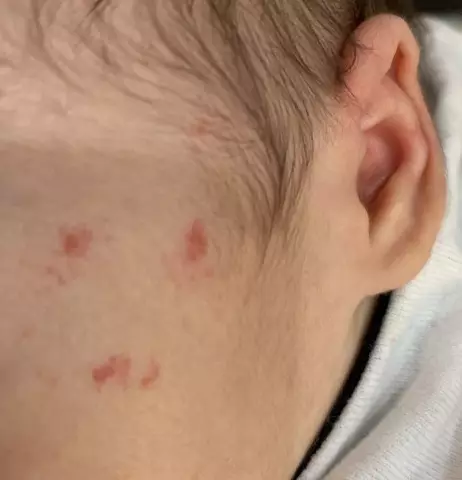- Author Rachel Wainwright [email protected].
- Public 2023-12-15 07:39.
- Last modified 2025-11-02 20:14.
Laryngospasm
The content of the article:
- Laryngospasm causes
- Laryngospasm symptoms
- Diagnostics
- Laryngospasm treatment
- Prevention
- Consequences and complications
Laryngospasm is a convulsive syndrome characterized by sudden contraction of the muscles of the larynx, closure of the glottis, loss of voice formation and impaired respiratory function.

This syndrome is based on increased reflex excitability of the neuromuscular apparatus of the larynx. During an attack, the arytenoid cartilage, to which the vocal cords are attached, come closer, the arytenoid ligaments, which limit the entrance to the larynx, are reduced to the midline, and the vocal cords are tightly closed. Partial or complete closure of the glottis proceeds with inspiratory dyspnea: after a noisy inhalation, breathing becomes intermittent and shallow, then stops for a while, since the flow of air into the respiratory tract is difficult.
Laryngospasm is more common in children than in adults and can be threatening. In the appearance of laryngospasm in newborns and infants, the imperfection of the protective function of the larynx plays a role in connection with the physiological underdevelopment of reflexogenic zones.
Laryngospasm causes
The causes of laryngospasm can be divided into general and local. Common reasons include:
- perinatal pathology;
- birth trauma;
- hypoxia;
- hypercapnia;
- lack of calcium in the body;
- hypovitaminosis D, rickets;
- decreased body reactivity;
- spasmophilia (a tendency to seizures and spasms);
- chorea and other neurological pathologies;
- rabies;
- tetanus;
- gastrointestinal disorders;
- hydrocephalus;
- disorders of cerebral circulation;
- respiratory diseases;
- gallbladder disease;
- psychological trauma;
- helminthic invasions;
- allergic reactions;
- instillation of biologically active substances into the nasal passages;
- acidosis.
Local causes include pathologies of the larynx - increased excitability of the reflex neuromuscular apparatus of the larynx, anomalies in the development of the larynx, laryngitis, as well as compression of the recurrent nerve by a hyperplastic thymus gland, enlarged bronchial nodes, and collateral edema.
Sometimes the attack is preceded by a cough, screaming, fright, manipulations in the laryngeal part of the pharynx. Often, laryngospasm occurs as a response to inhalation of air containing irritants of allergenic and chemical origin (aerosols, cold air), when exposed to irritating drugs, when young children swallow various substances and foreign bodies (small toys, buttons, parts).
Laryngospasm symptoms
Laryngospasm occurs suddenly, without a prodromal period, accompanied by wheezing noisy breathing, sharp excitement, attempts to cough up, shortness of breath, temporary cessation of breathing. At the time of the spasm, the head tilts back, the neck muscles tense, the eyes and mouth open wide, drops of cold sweat appear on the forehead, the pulse becomes threadlike, the skin is pale or bluish, muscle cramps of the face and limbs may appear, foam from the mouth.
A typical picture of the disease is manifested by spastic disorders of the speech muscles, closure of the glottis, apnea, followed by a long, hoarse breath. After 10-60 seconds after a long loud inhalation, exhalation follows and a gradual normalization of respiratory function. Apnea is sometimes accompanied by severe oxygen deprivation with cyanosis and loss of consciousness. With chorea, a number of swallowing and respiratory disorders, speech disorders resembling stuttering, movement disorders of the tongue join the typical symptoms of laryngospasm, at the same time, jaw clenching can occur.
Laryngospasm attacks can be prolonged, more often during the day, and can be repeated several times a day for several months, alternating with periods of calm. If a child has had an attack of laryngospasm at least once, it may recur even after a considerable period of time and for another reason. The syndrome is characterized by seasonality: seizures usually stop in the summer and resume in the winter.

Laryngospasm attacks in adults can resemble epileptic ones and are combined with convulsions of the limbs, pharynx, esophagus.
Diagnostics
The diagnosis is made by an otolaryngologist after examining the history and clinical picture. When collecting anamnesis, all the circumstances of the perinatal period, the onset and sequence of the development of symptoms of laryngospasm, the presence of concomitant diseases, and previous treatment are clarified in detail. Inspection of the laryngeal cavity becomes possible only after the spasm has weakened.
Laryngospasm treatment
Assisting with laryngospasm consists of taking emergency measures during an attack.
- Eliminate the action of possible irritants. If you suspect that a foreign object has been swallowed, the patient should be lowered upside down and shaken sharply.
- Place the patient on a firm, level surface to create absolute (if possible) silence.
- Provide fresh air and ventilation in the room, facilitate air access to the lungs by removing the top layer of clothing.
- Reflex methods for relieving spasm: sprinkle the patient's face with water, irritate the nasal mucosa with a cotton flag, blow into the nose, press the root of the tongue with a spatula, induce a gag reflex, carefully, trying not to cause a burn of the respiratory tract, bring ammonia (children are not recommended).
Spasm of allergic origin is stopped by antihistamines.
If there is a threat of asphyxia, tracheal intubation or tracheotomy is used to ensure airway patency. In case of cardiac arrest, resuscitation measures are carried out: indirect heart massage through the chest and the introduction of anticonvulsants.
Laryngospasm therapy is primarily aimed at eliminating etiological factors. The underlying disease is being treated, against the background of which laryngospasm develops, immunostimulating therapy and physical hardening are shown between attacks.
Prevention
Basic preventive measures:
- fortifying measures, hardening;
- ultraviolet irradiation;
- baths with potassium bromide;
- inhalation with mineral water, saline, according to indications - drug solutions;
- humidification of air in the room;
- balanced diet;
- vitamin therapy with a high vitamin D content;
- taking calcium supplements;
- regular walks in the clean and fresh air;
- correct daily routine, good rest and sleep;
- regular implementation of a set of exercises aimed at relaxing muscles, massage.
Consequences and complications
In severe cases, laryngospasm ends in acute muscle cramps, respiratory failure, heart failure, and loss of consciousness. A prolonged attack is dangerous by the development of asphyxia, it can cause coma and death.
With timely diagnosis, elimination of traumatic injuries of the larynx and adequate treatment of diseases, the prognosis is favorable. As a rule, laryngospasms go away as the child gets older.
YouTube video related to the article:

Anna Kozlova Medical journalist About the author
Education: Rostov State Medical University, specialty "General Medicine".
The information is generalized and provided for informational purposes only. At the first sign of illness, see your doctor. Self-medication is hazardous to health!






